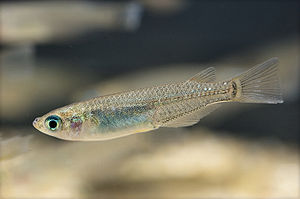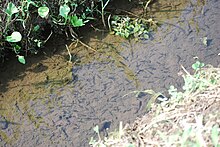Medaka
| Medaka | ||||||||||||
|---|---|---|---|---|---|---|---|---|---|---|---|---|

Medaka ( Oryzias latipes ) |
||||||||||||
| Systematics | ||||||||||||
|
||||||||||||
| Scientific name | ||||||||||||
| Oryzias latipes | ||||||||||||
| ( Temminck & Schlegel , 1846) |
The medaka ( Oryzias latipes ), also Japanese rice fish or rice carrot , is a Southeast Asian fish from the rice fish family (Adrianichthyidae), which is important as an aquarium fish and model organism in biological research.
features
Medaka reach a length of up to about three and a half centimeters. Their body is flattened on the sides, the head is about a quarter of the standard length . The mouth is terminal with jaws of about the same length or slightly longer lower jaw. The eyes are medium-sized and do not protrude above the top of the head. The scales are relatively large cycloid scales , 28 to 32 of which lie along the body. The body is translucent with scattered, dark melanophores that form more or less distinct dark rows from the back of the head to the base of the dorsal fin and on the flank from the head to the caudal fin. The gill cover and the peritoneum are silver; the latter is roughly rectangular in the females, smaller and triangular in the males. The dorsal fin has 5 to 7 rays, the anal fin has 17 to 22. In the males, the rays of both fins are elongated and there is a clear notch between the last two rays of the dorsal fin. The pectoral fins have 9 to 11 and the pelvic fins 5 to 7 rays, which in the females are partially elongated and almost reach the anal fin. The caudal fin has one undivided and four or five articulated rays in the upper and lower half, as well as five procurrent rays dorsally and six ventrally. The number of Branchiostegal rays is five to six, those of the vertebrae 27 to 32.
Occurrence
The Medaka occurs from Laos and Vietnam to eastern China and Korea and on the Japanese islands from the Ryūkyū Islands to Honshū . It mostly inhabits standing or slowly flowing fresh and brackish waters such as ponds or rice fields.
Taxonomy
The medaka was in 1846 by Coenraad Jacob Temminck and Hermann Schlegel scientifically Poecilia latipes described . In 1866 the species was assigned to a genus Haplochelus by Albert Günther and placed in the genus Aplocheilus in 1901 by David Starr Jordan and John O. Snyder . In 1906 Jordan and Snyder then described the genus Oryzias with the Medaka as the only one and a type that differs from Aplocheilus in the lack of teeth on the ploughshare . In fact, the ploughshare is missing from the genus Oryzias . The generic name Oryzias refers to the occurrence of fish in rice fields (generic name Oryza ), the specific epithet latipes is derived from Latin latus "broad" and pes "foot".
Individual evidence
- ^ Gary Kent Ostrander: The laboratory fish Handbook of experimental animals . Elsevier, 2000, ISBN 0-12-529650-9 , pp. 43 .
- ↑ a b Lynne R. Parenti: A phylogenetic analysis and taxonomic revision of ricefishes, Oryzias and relatives (Beloniformes, Adrianichthyidae) . In: Zoological Journal of the Linnean Society . tape 154 , 2008, p. 494–610 (English, si-pddr.si.edu [PDF; 3.9 MB ] full text).
- ↑ Medaka on Fishbase.org (English)
- ^ Coenraad Jacob Temminck, Hermann Schlegel: Les Poecilies . In: Fauna Japonica . 1846, p. 224–225 (French, full text in French: p. 224 , p. 225 and figure number V in the online offer of Kyoto University).
- ↑ a b David S. Jordan, John O. Snyder: A REVIEW OF THE PŒCILIIDÆ OR KILLIFISHES OF JAPAN. In: Proceedings of the United States National Museum . tape 31 , 1906, pp. 287–290 (English, repository.si.edu [PDF; 319 kB ] full text).
- ^ Tokyo Yamamoto: Systematics and Zoogeography . In: Tokio Yamamoto (Ed.): Medaka, Biology and Strains . Yugakusya Publisher, 1975, OCLC 3361739 , p. 17–29 (English, bio.nagoya-u.ac.jp ( Memento from September 23, 2005 in the Internet Archive ) - full text). Systematics and Zoogeography ( Memento of the original from September 23, 2005 in the Internet Archive ) Info: The archive link was automatically inserted and has not yet been checked. Please check the original and archive link according to the instructions and then remove this notice.
Web links
- Medaka on Fishbase.org (English)
- Oryzias sinensis inthe IUCN 2013 Red List of Threatened Species . Posted by: Parenti, L., 2011. Retrieved February 8, 2014.
- Stephanie Schnydrig: Neurotoxins damage aquatic organisms differently than expected. In: eawag.ch . June 13, 2019, accessed July 17, 2019 .
